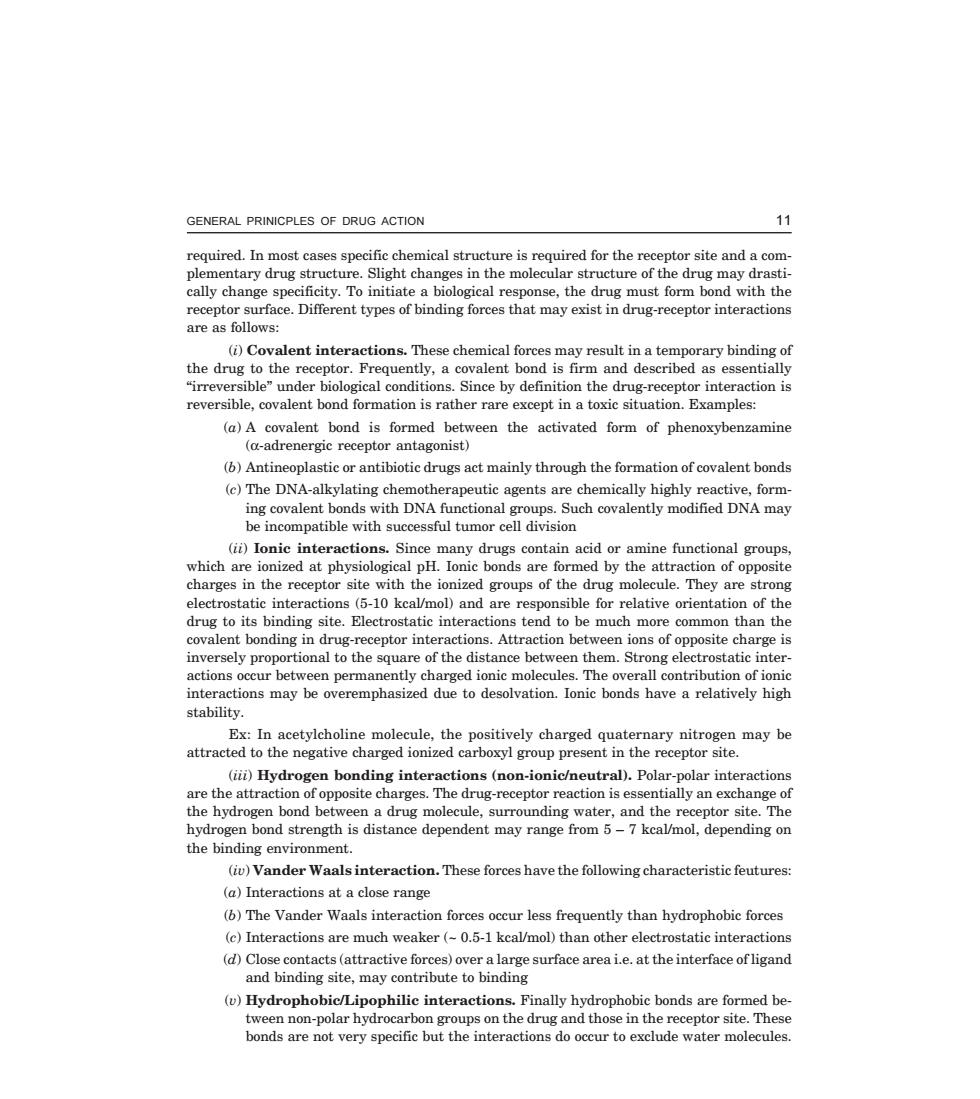正在加载图片...

GENERAL PRINICPLES OF DRUG ACTION required.In most cases specific chem ary drug str cally change 之aao (i)Covalent interactions.These chemical forces may result in a temporary binding of the drug to the receptor.Frequently,a covalent bond is firm and described as essentially biological conditions.Since by definition the drug-receptor interaction is reverbecalent bond formation is rather rare except in a toic sitution.Eample (a)A covalent bond is formed between the activated form of phenoxybenzamine (a-adrenergic receptor antagonist) ()Antineoplastic or antibiotic drugs act mainly through the formation of covalent bonds (c)The DNA-alkylating chemotherapeutic agents are chemically highly reactive,form (ii)Ionic interactions.Since many drugs contain acid or amine functional groups, which are ionized at physiological pH.Ionic bonds are formed by the attraction of opposite charges in the receptor site with the ionized groups of the drug molecule.They are strong electrostatic interactions(5-10 kcal/mol)and are responsible for relative orientation of the drug to its binding site.Electrostatic interactions tend to be much more common than the covalent bonding in drug-receptor interactions.Attraction between ions of opposite charge is en them.str ng electrostatic inter ccur be en perm have a relative contrib ation. ively high Ex:In acetylcholine molecule,the positively charged quaternary nitrogen may be attracted to the negative charged ionized carboxyl group present in the receptor site. (ii)Hvdrogen bonding interactions (non-ionic/neutral).Polar-polar interaction are the attraction of DD site cha res.The drug-receptor reaction is essentially an exchange of en a drug molecule surrounding water and the tor site The hydrogen bond strength is distance dependent may range from 5-7 kcal/mol,depending on the binding environment. (iv)Vander Waals interaction.These forces have the following characteristic feutures (a)Interactions at a close range (b)The vander waals interaction forces occur less frequently than hydrophobic forces (c)Interactions are much weaker(-0.5-1 kcal/mol)than other electrostatic interaction (d)Close contacts(attractive forces)over a large surface areai.e.at the interface ofligand and binding site.may contribute to binding (Hvdrophobic lipophilic interactions.Finally hydrophobic bonds are formed be tween non-polar hydrocarbon gro ps on the drug and those in the receptor site.these bonds are not very specific but the interactions do occur to exclude water molec lesGENERAL PRINICPLES OF DRUG ACTION 11 C-8—N-CHEMI\CHE2-1.PM5 required. In most cases specific chemical structure is required for the receptor site and a complementary drug structure. Slight changes in the molecular structure of the drug may drastically change specificity. To initiate a biological response, the drug must form bond with the receptor surface. Different types of binding forces that may exist in drug-receptor interactions are as follows: (i) Covalent interactions. These chemical forces may result in a temporary binding of the drug to the receptor. Frequently, a covalent bond is firm and described as essentially “irreversible” under biological conditions. Since by definition the drug-receptor interaction is reversible, covalent bond formation is rather rare except in a toxic situation. Examples: (a) A covalent bond is formed between the activated form of phenoxybenzamine (α-adrenergic receptor antagonist) (b) Antineoplastic or antibiotic drugs act mainly through the formation of covalent bonds (c) The DNA-alkylating chemotherapeutic agents are chemically highly reactive, forming covalent bonds with DNA functional groups. Such covalently modified DNA may be incompatible with successful tumor cell division (ii) Ionic interactions. Since many drugs contain acid or amine functional groups, which are ionized at physiological pH. Ionic bonds are formed by the attraction of opposite charges in the receptor site with the ionized groups of the drug molecule. They are strong electrostatic interactions (5-10 kcal/mol) and are responsible for relative orientation of the drug to its binding site. Electrostatic interactions tend to be much more common than the covalent bonding in drug-receptor interactions. Attraction between ions of opposite charge is inversely proportional to the square of the distance between them. Strong electrostatic interactions occur between permanently charged ionic molecules. The overall contribution of ionic interactions may be overemphasized due to desolvation. Ionic bonds have a relatively high stability. Ex: In acetylcholine molecule, the positively charged quaternary nitrogen may be attracted to the negative charged ionized carboxyl group present in the receptor site. (iii) Hydrogen bonding interactions (non-ionic/neutral). Polar-polar interactions are the attraction of opposite charges. The drug-receptor reaction is essentially an exchange of the hydrogen bond between a drug molecule, surrounding water, and the receptor site. The hydrogen bond strength is distance dependent may range from 5 – 7 kcal/mol, depending on the binding environment. (iv) Vander Waals interaction. These forces have the following characteristic feutures: (a) Interactions at a close range (b) The Vander Waals interaction forces occur less frequently than hydrophobic forces (c) Interactions are much weaker (~ 0.5-1 kcal/mol) than other electrostatic interactions (d) Close contacts (attractive forces) over a large surface area i.e. at the interface of ligand and binding site, may contribute to binding (v) Hydrophobic/Lipophilic interactions. Finally hydrophobic bonds are formed between non-polar hydrocarbon groups on the drug and those in the receptor site. These bonds are not very specific but the interactions do occur to exclude water molecules